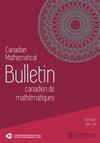描述$(-2,3,7)$椒盐卷饼结的斜率
IF 0.4
4区 数学
Q3 MATHEMATICS
Canadian Mathematical Bulletin-Bulletin Canadien De Mathematiques
Pub Date : 2022-09-21
DOI:10.4153/S0008439523000073
引用次数: 0
摘要
在本文中,我们展示了表征$12n242$结(也称为$(-2,3,7)$ -pretzel结)斜率的具体例子。虽然拉肯比证明了每个结都有无限多个表征斜率,但该证明的非构造性意味着很少有双曲结能给出表征斜率的显式例子。本文章由计算机程序翻译,如有差异,请以英文原文为准。
Characterizing slopes for the
$(-2,3,7)$
-pretzel knot
Abstract In this note, we exhibit concrete examples of characterizing slopes for the knot
$12n242$
, also known as the
$(-2,3,7)$
-pretzel knot. Although it was shown by Lackenby that every knot admits infinitely many characterizing slopes, the nonconstructive nature of the proof means that there are very few hyperbolic knots for which explicit examples of characterizing slopes are known.
求助全文
通过发布文献求助,成功后即可免费获取论文全文。
去求助
来源期刊
CiteScore
1.30
自引率
0.00%
发文量
68
审稿时长
24 months
期刊介绍:
The Canadian Mathematical Bulletin was established in 1958 to publish original, high-quality research papers in all branches of mathematics and to accommodate the growing demand for shorter research papers. The Bulletin is a companion publication to the Canadian Journal of Mathematics that publishes longer papers. New research papers are published continuously online and collated into print issues four times each year.
To be submitted to the Bulletin, papers should be at most 18 pages long and may be written in English or in French. Longer papers should be submitted to the Canadian Journal of Mathematics.
Fondé en 1958, le Bulletin canadien de mathématiques (BCM) publie des articles d’avant-garde et de grande qualité dans toutes les branches des mathématiques, de même que pour répondre à la demande croissante d’articles scientifiques plus brefs. Le BCM se veut une publication complémentaire au Journal canadien de mathématiques, qui publie de longs articles. En ligne, il propose constamment de nouveaux articles de recherche, puis les réunit dans des numéros imprimés quatre fois par année.
Les textes présentés au BCM doivent compter au plus 18 pages et être rédigés en anglais ou en français. C’est le Journal canadien de mathématiques qui reçoit les articles plus longs.

 求助内容:
求助内容: 应助结果提醒方式:
应助结果提醒方式:


